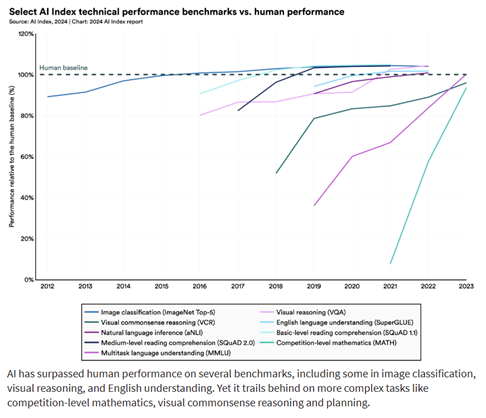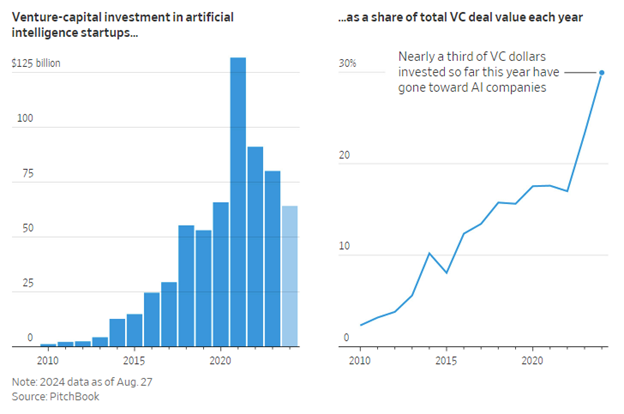Artificial Intelligence: Unveiling the Opportunities Beyond the Hype
Artificial intelligence (AI) has become a dominant theme in recent years, with potential for broad-reaching and in some ways transformational impacts on business and society. Given the huge amount of attention it has received, we want to share how we think about AI in how we build and manage investment portfolios.
In considering the investment implications of AI, an internal consideration is how it can potentially be a tool to enhance our investment decision making, while a far broader consideration is how AI may impact individual businesses, sectors, industries and the global economy. While we are always seeking to improve our own processes and decision making – and this includes consideration for AI -related research tools – our focus in this piece is on the broad business and investment implications of AI as it plays out in the years ahead.
Looking broadly at AI in an investment context, we will focus on two main areas. The first is direct investment in companies that are building these capabilities. The second is the broader impact of AI across the economy as it fosters new efficiencies and innovations that can create opportunities along with disruption. And as is the case with any investment analysis, what we know about businesses’ ability to deliver or benefit from AI must be considered in the context of the level of growth that is baked into current valuations. In other words, a company’s revenues and profits may benefit tremendously from AI, but if its valuation already reflects that level of benefit (or more) because of investor enthusiasm, the company’s stock still might not be a good investment at its current price.
Understanding the AI Landscape
In terms of companies involved in building and empowering AI capabilities, it’s a broad and often intertwined universe not confined to pure-play AI companies, and some of the behemoths like Google, Microsoft and Meta are making significant investments in multiple areas. Broadly speaking, in the interest of providing an overview of what the direct investing landscape for AI looks like, we would use the following classifications.
Applications and Services for Consumers which typically make use of conversational AI (such as chat-bots) and generative AI (which can create new text, images or video). An example is OpenAI, maker of ChatGPT.
Infrastructure and Cloud Providers that supply advanced and specialized computing capabilities and data storage, such as Amazon Web Services.
Hardware including specialized graphics and processing chips; an example is Nvidia.
Specialized AI business services that include companies offering enterprise-level AI platforms, specific AI business solutions, and data labeling used to foster machine learning. Examples include Data Robot, Tempus, and Scale AI.
Multicategory tech giants like Microsoft and Google with forays into multiple areas of AI.
Beyond these categories of companies on the front lines of building out AI capabilities are the literally thousands of other companies potentially poised to benefit, or in some cases suffer harm, from the burgeoning abilities of AI to impact and in some cases even transform businesses.
AI’s Potential Impact on the Broader Economy
In the years ahead we believe AI has broad-ranging implications for other companies/industries, in which we will see both disruption and creation leading to efficiencies and productivity growth across the economy as a whole. While all the ways in which this plays out can’t be known, an early example includes call centers, where AI is automating routine tasks and reducing the need for human agents. A broader industry-specific AI business opportunity can be found in health care, where companies offer AI-driven solutions to improve data management, medical imaging, and diagnostics. And AI technology like machine learning (ML) is powering developments in areas like robotics, genomics, and internet content, advertising and search capabilities.
Less AI regulation in the U.S. could lead to greater economic benefit (and potential risk) here versus abroad.
In our world of investment management, over 90% of investment managers surveyed by Mercer were using AI in some capacity – from basic productivity enhancement (summaries) to ML in quant-heavy strategies that have been happening for a long time.
The chart below shows the rapid pace at which AI capabilities have improved relative to a benchmark of humans performing the same tasks. How these capabilities are improved and harnessed to improve business performance will be a major leg in the ongoing AI evolution.

Is the Hype About AI Likely to Create a “Bubble”?
Despite the excitement around AI, an analysis of the investment opportunities it presents requires, as always, an objective assessment of valuations and potential for future earnings. Though our investment approach does not typically involve making specific sector or industry bets, we can offer some general comments and observations on AI through an investment lens and review how we factor AI considerations into the investment work we do.
The biggest story with AI is the massive amount of capital spending and investment that is fueling the boom, and the biggest question is whether the exuberance around AI will result in a “bubble”.
Valuations are rich for many AI and adjacent businesses in public and private markets. OpenAI raised $6.6bn at a total $150bn valuation, but there remains debate about whether how profitable it will eventually be given the massive energy and computing cost involved. Their focus on making steady improvements to ChatGPT and other products has, however, borne fruit. Its annualized revenue—a projection of yearly receipts based on recent results—recently hit about $4 billion, more than triple from the same time last year. It is still losing billions a year, however (according to the Wall Street Journal).
In the realm of “picks and shovels,” hardware maker Nvidia has become the most profitable “shovel” company in the history of the world, with $30bn in quarterly revenue; other suppliers are also benefitting, as well as data center companies and utilities (one of the best performing sectors in the U.S. stock market this year).
When ChatGPT was launched in November 2022 its capabilities generated lots of headlines as the wider public got a firsthand look at the potential of AI. With huge amounts of capital investment going into AI, companies on the front lines of delivering AI capabilities, like Nvidia, have soared.
Capital spending (capex) from the “Magnificent 7” (megacap tech stocks), much of which relates to AI, has been a growth driver: total capex for these same seven companies in Q1 2020 was around $15 billion; in Q3 2024 it soared to almost $53 billion. From a business strategy standpoint, Sundar Pichai, chief executive of Google parent Alphabet, offered a succinct rationale for this spending during a company earnings call in July 2024: “The risk of underinvesting is dramatically greater than the risk of overinvesting.”
In terms of investment, the volume and share of private venture capital (VC) investment in AI-related startups has spiked in recent years. As the chart below shows, nearly a third of all VC dollars flowed into AI investments this year. The volume of private investment also serves as a reminder of how far the AI world extends beyond publicly traded companies that may garner more headlines.

Markets are forward-looking and lofty valuations result when growth assumptions are high far into the future – a phenomenon compounded by very strong concurrent investor demand. Such is the case for AI, but to use a word like “bubble” risks oversimplifying a complex and still rapidly evolving realm.
On the one hand, a partner at the venture-capital firm Sequoia Capital estimated how far ahead of itself one section of the industry could be; he calculated that to justify this year’s investment in data centers and chips alone, AI businesses will ultimately need to generate $600 billion in revenue. Though most companies don’t disclose their revenue from AI, analysts have estimated the annual total is at most in the tens of billions of dollars.
The far-higher energy consumption of AI computing has contributed to an almost ten-fold increase in data center energy use over the past 10 years.
Ultimately the AI boom could wind up as an example of the “Gartner Hype Cycle,” in which the initial “technology trigger” holds so much promise that it creates hugely inflated valuations, which is then followed by a correction that bottoms with a “trough of disappointment” that is eventually followed by stable growth as the initial promise is delivered. The obvious echo here is the internet boom/bust. We saw huge valuations based on transformative technology that eventually did fulfil its promise, but where the cumulative valuation of all companies can’t be justified and where we won’t know the ultimate winners for years. And even the winners may take years to grow into their current valuations.
But a key point is that the breadth of AI as a transformational technology is huge, and in the context of a bubble it suggests that while some of the more pure-play areas of the AI market are likely overvalued due to speculative exuberance (like generative AI), companies that provide AI infrastructure and solutions to other industries (such as health care or finance) may have more sustainable and stable growth prospects and thus more justifiable valuations.
That doesn’t mean those companies can’t or won’t reach bubble levels individually. In our work selecting active managers who we believe have the skill to beat their index benchmarks, we find it important to understand how they analyze individual companies. This includes uncovering how these managers make assumptions about future growth and business risk, and how they factor AI-related impacts into their company analysis.
As for the portfolios we manage for our clients, if we believe AI (or any external factor for that matter) is contributing to an opportunity or a risk in a particular area of the market that has not yet been priced in, that could impact our portfolio allocation decisions. But whether AI considerations are an explicit factor in an investment decision or a residual one, our investment portfolios will inevitably see major participation in everything that AI brings to the business landscape and global economy, because we diversify our equity portfolios globally. Business is competitive and companies seek any advantage they can gain in creating and sustaining their success, and we believe AI will clearly be part of this.
If you have more questions about our thoughts on AI, or about your own portfolio and situation, please feel free to contact your Advisor for further discussion.
